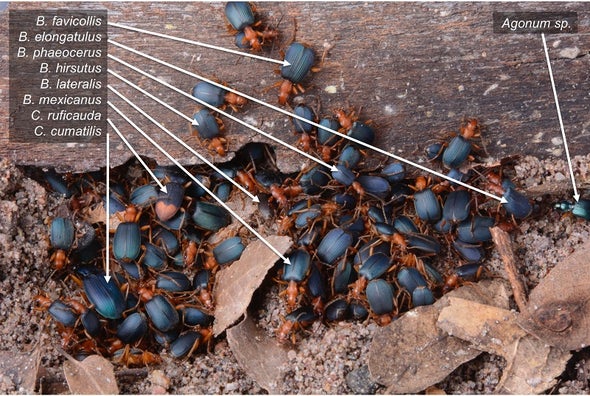(单词翻译:单击)
听力文本
This is Scientific American's 60-second Science, I'm Bob Hirshon.
If you're a skunk, or fox, or very strange person, and you poke your nose under a rock in the desert Southwest, looking for something to eat, you might be surprised to see dozens of bright blue and red beetles scurrying to and fro. And you might be really curious as they quickly turn their butts toward you.
But the curiosity wouldn't last long: a couple thousandths of a second later, a fusillade of boiling hot, toxic spray would drive off both you and your musings.
The insects with the spraying butts are fittingly named bombardier beetles. And they can fire off 500 pulses per second of caustic defensive chemicals. What also makes them unusual is that even though the nocturnal beetles are solitary by night, dozens or even hundreds of them—of various bombardier species—snuggle together under rocks during the day.
"It's actually a fairly unusual phenomenon for different species to regularly associate with one another."
University of Arizona entomologist Wendy Moore.

"But these guys are sheltering together, and they're actually doing it intentionally, you know, because they have more options. There's plenty of options within the habitat that they could actually segregate out by species, and they don't."
In fact, when Moore and her colleagues put beetles into a setting where they had cozy solitary hiding places, as well as hiding places already packed with other beetles, the newcomers invariably chose to shelter with others under the crowded rocks. The study is in the journal PLOS One.
Moore says buddying up may help protect the insects from predators.
"Bombardier beetles produce benzoquinones, which are really powerful as a matter of defense, but these other beetles produce other kinds of defensive chemicals that probably contribute to a big chemical cocktail for a vertebrate predator that might find them during the day."
In addition, a lone beetle, no matter how brightly colored, might not scare off a predator as effectively as a whole bunch of beetles.
"If you imagine being a predator, even a human, turning over a rock and seeing hundreds of these blue and red beetles going in every direction, that serves as a bigger advertisement to them of their toxicity. It may help them be able to avoid attack."
So whatever you can say about an encounter with these fearsome little insects, you can't say that you weren't warned.
Thanks for listening for Scientific American — 60-Second Science. I'm Bob Hirshon.
参考译文
这里是科学美国人——60秒科学系列,我是鲍勃·赫尔尚。
如果你是臭鼬,或狐狸,或是非常奇怪的人,你在西南沙漠将鼻子伸进岩石下面寻找食物时,可能会惊讶地发现几十只鲜艳的蓝色和红色的甲虫在跑来跑去。它们会迅速将臀部朝向你,这可能会令你非常好奇。
但这种好奇不会持续太久:千分之几秒后,滚烫且有毒的喷雾一齐发射,这会将你和你的沉思全部驱散。
这种屁股会喷射的昆虫有个非常贴切的名字:投弹手甲虫。它们每秒能发射500脉冲的腐蚀性防御化学物质。它们另一个不同寻常之处在于,尽管这种夜行性甲虫习惯在夜间独处,但在白天,会有数十只甚至数百只不同种类的投弹手甲虫蜷缩在岩石下面。
“不同种类的甲虫规律性地聚在一起,这是一种相当不寻常的现象。”
亚利桑那大学的昆虫学家温迪·摩尔说到。
“但这些家伙是在一起避难,它们实际上是有意这样做的,因为它们有更多选择。在栖息地它们有很多选择,它们可以按照种类分别聚集,但它们没有这样做。”
事实上,当摩尔及其同事将甲虫分别放到舒适的独自藏身地或挤满其它甲虫的躲藏处时,新来者总是选择和其它甲虫一起躲在挤满甲虫的岩石下。这项研究发表在《公共科学图书馆·综合》期刊上。
摩尔表示,结伴有助于甲虫免受捕食者的伤害。
“投弹手甲虫会产生苯酚类物质,这是一种非常强大的防御物质,但其它甲虫也会产生其他种类的防御性化学物质,这些物质可能会促成一种大型化学混合物,以攻击在白天可能找到它们的脊椎动物捕食者。”
另外,一只甲虫要单枪匹马地吓跑捕食者,无论其颜色有多鲜艳,都不可能像一群甲虫那样有效。
“如果想象自已是捕食者,或是我们人类本身,你翻开石头,看到数百只这种蓝色和红色的甲虫在向各个方向逃跑,这种情况会加大其毒性的广告效应。这可能有助于它们避免遭遇攻击。”
因此,无论你在遇到这些可怕的小昆虫之后说些什么,都不能说它们没有警告你。
谢谢大家收听科学美国人——60秒科学。我是鲍勃·赫尔尚。
译文为可可英语翻译,未经授权请勿转载!
重点讲解
重点讲解:
1. to and fro 往返地;来回地;
She rocked the baby to and fro.
她来回摇动着婴儿。
2. drive off 击退;赶走;
Men drove off the dogs with stones.
人们用石头赶走了狗群。
3. buddy up 亲近(某人),(和某人)结交;
If you buddy up with someone from work, you'll be less likely to skip out on trips from the office to the gym.
如果你和工作伙伴一起,就不太会逃避从办公室到健身房的那段路了。
4. scare off 吓跑;
Don't get closer, or you will scare off those cute birds.
不要再靠近了,不然你会把那些可爱的鸟给吓跑。


